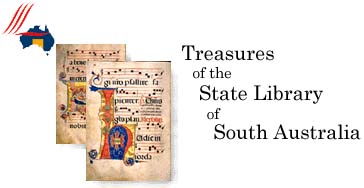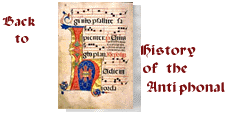
 |
|


The treatment of the Antiphonal has been a joint project between
Artlab Australia, and the Rare Book Librarians and Conservation
Services of the State Library of South Australia.
Artlab Australia is a business enterprise
of Arts South Australia, part of the South Australian Government
Department for Transport, Urban Planning and the Arts. It provides
a broad range of material conservation services, covering three
dimensional artefacts, textiles, paper-based materials, paintings,
books and photographs, and also manages on-site projects. It is
currently involved in large projects in Canberra, Melbourne, Sydney
and South East Asia and is also responsible for the conservation
programs of local major collecting institutions including the
South Australian Museum and the Art Gallery of South Australia.
The Conservation Services of the State Library of South Australia
provides an in-house service to the Library. It is responsible
for disaster management, preventative conservation, preservation
storage and housing, and environmental monitoring. It specialises
in paper and skin-based media. It also provides advice to members
of the public, and stages outreach workshops for country public
libraries, promoting conservation and preservation awareness within
the community.
We hoped the project would lead to closer working relationships
between the two organisations. It has achieved this and more,
providing all team members with opportunities to improve their
skills and knowledge of conservation decision-making, of conservation
techniques, of new technologies and working with the staff of other institutions. All the conservators who worked on the Antiphonal brought
different knowledge and skills to the project and all team members
benefited from this. In making decisions about the preservation of a book of this age, it is important to
The materials from which the Antiphonal is made- Vellum writing surface
The pages are made from vellum. Paper had been introduced into
Europe by this time but its use was not widespread.
Vellum and parchment are made from the untanned skins of animals
such as calves and stillborn lambs (vellum) and sheep and goats
(parchment). The manufacture of vellum involves washing and scraping
to remove fat and hair, treatment with lime, further scraping
and washing, followed by stretching the skins tightly on a frame.
During stretching the skins are scraped again to remove surface
irregularities. Various finishing processes can be applied depending
on the final finish required.
Vellum and parchment are extremely sensitive to changes in relative
humidity and will distort as they take up or give out moisture.
The original "cords" onto which the book was sewn are
likely to have been strips of alum-tawed leather, tanned leather,
flat or twisted vellum strips or cord. All of these materials
are strong, durable and flexible. Certainly in subsequent bindings
cords were used. These may well have been made from hemp.
The original sewing thread was likely to have been linen. Linen
is one of the oldest fibres used by man. It is made from the bast
fibres - the inside bark - fibres of the flax plant, Linum usitatissimum.
Cotton is unlikely to have been used at all. Although cotton was
known in Europe in the 13th century - having been introduced to
Spain by the Moors - its use was not widespread until the 17th
and 18th centuries. Boards
The original boards on the book would have been wooden. They could
easily have been as thick as the current boards and may have been
rough-hewn. Heavy wooden boards were required to keep the vellum
pages flat.
Boards manufactured from layers of paper, i.e. pasteboards were
not produced commercially in Europe until 1580. These would not
have had the weight to hold the moisture-sensitive vellum pages
in place.
At the time this book was produced boards were attached to the
textblock by lacing the sewing cords into holes drilled into the
boards. The laced in cords, along with the leather spine covering
and endpapers, formed a strong flexible joint between textblock
and boards. Leather
Unfortunately we have no evidence of the type of leather used
to cover the original spine of the book. However, it is almost
certain that leather was used. Leather used for bookbinding was
produced from a range of domestic and wild animals, such as oxen,
asses, calves, sheep, pigs, horses, stags, goats and seals.
In medieval books the leather was pasted over the spine of the
book and pulled over the boards far enough to cover the joint
where the boards were laced to the cords. Later the leather covered
the whole of the back and front boards. Headbands No evidence was found in the book of original headbands. Had they been there they could have been made from a core of cord, vellum, alum tawed leather or gut. The sewing of the headbands was usually part of the book sewing operation, with the sewing thread passing through the book sections and passing over the headbands without any interruption. Illuminations and main text The ink will have been carbon-based, with a binding medium such as gum arabic, and the judicious addition of water as necessary to make the ink flow. The pigments used in the illuminations were derived from vegetable or mineral sources. Dry pigments were usually mixed with water, and a binding medium added, such as egg-yolk, egg-white or gelatin made from parchment size. No specific analysis was done of ink or pigments in this manuscript because we did not wish to remove any fragments.
As a general guide, the vermilion red is mercuric sulphide, also
known as cinnabar, yellow comes from the spice saffron, green
was often copper sulphide, and the most brilliant and expensive
blue came from ground lapis lazuli. The gold is gold leaf, mounted
on a gesso.  Copyright and this website | Disclaimer | Privacy | Feedback | Accessibility | Freedom of Information | Last update on 20 December 1997 The URL for this page is http://www.slsa.sa.gov.au/treasures/antiphonal/conserv.htm |